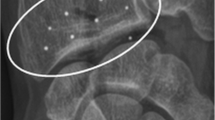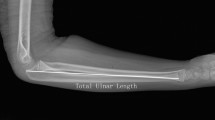Abstract
Purpose
Surgical procedures for impaired forearm rotation such as for chronic radial head dislocation remain controversial. We hypothesized that the morphological axis of the proximal radius is important for stable forearm rotation, and we aimed to clarify the relationship between the morphological axis and the kinematic axis of the proximal radius using four-dimensional computed tomography (4DCT).
Methods
Ten healthy volunteers were enrolled. Four-dimensional CT of the dominant forearm during supination and pronation was obtained. The rotation axis of forearm rotation was calculated from all frames during supination and pronation. The principle axis of inertia, which represents the most stable rotation axis of a rigid body, was calculated for the proximal radius by extending its surface data incrementally by 1% from the proximal end. The angle between the kinematic rotation axis and the morphological rotation axis of each length was calculated.
Results
The rotation axis of the forearm was positioned on the radial head 0.0 mm radial and 0.4 mm posterior to the center of the radial head proximally and 2.0 mm radial and 1.2 mm volar to the fovea of the ulnar head distally. The principle axis at 15.9% of the length of the proximal radius coincided with the forearm rotation axis (kinematic axis). Individual differences were very small (SD 1.4%).
Conclusion
Forearm rotation was based on the axis at 16% of the length of the proximal radius. This portion should be aligned in cases of severe morphological deformity of the radial head that cause “rattling motion” of the radial head after reduction procedures.





Similar content being viewed by others
References
Caravias DE (1957) Some observations on congenital dislocation of the head of the radius. J Bone Jt Surg Br 39-B:86–90
Chen HY, Wu KW, Dong ZR, Huang SC, Kuo KN, Wang TM (2018) The treatment of chronic radial head dislocation in Monteggia fracture without annular ligament reconstruction. Int Orthop 42:2165–2172. https://doi.org/10.1007/s00264-018-3943-6
Futami T, Tsukamoto Y, Fujita T (1992) Rotation osteotomy for dislocation of the radial head. 6 cases followed for 7 (3–10) years. Acta Orthop Scand 63:455–456
Gamage SS, Lasenby J (2002) New least squares solutions for estimating the average centre of rotation and the axis of rotation. J Biomech 35:87–93
Gleeson AP, Beattie TF (1994) Monteggia fracture-dislocation in children. J Accid Emerg Med 11:192–194
Goyal T, Arora SS, Banerjee S, Kandwal P (2015) Neglected Monteggia fracture dislocations in children: a systematic review. J Pediatr Orthop B 24:191–199. https://doi.org/10.1097/BPB.0000000000000147
Hansen C, Rezzoug N, Gorce P, Venture G, Isableu B (2016) Sequence-dependent rotation axis changes and interaction torque use in overarm throwing. J Sports Sci 34:878–885. https://doi.org/10.1080/02640414.2015.1076167
Isableu B, Rezzoug N, Mallet G, Bernardin D, Gorce P, Pagano CC (2009) Velocity-dependent changes of rotational axes in the non-visual control of unconstrained 3D arm motions. Neuroscience 164:1632–1647. https://doi.org/10.1016/j.neuroscience.2009.08.065
Kim HT, Conjares JN, Suh JT, Yoo CI (2002) Chronic radial head dislocation in children, Part 1: pathologic changes preventing stable reduction and surgical correction. J Pediatr Orthop 22:583–590
Lloyd-Roberts GC, Bucknill TM (1977) Anterior dislocation of the radial head in children: aetiology, natural history and management. J Bone Jt Surg Br 59-B:402–407
Miyake J, Moritomo H, Kataoka T, Murase T, Sugamoto K (2012) In vivo three-dimensional motion analysis of chronic radial head dislocations. Clin Orthop Relat Res 470:2746–2755. https://doi.org/10.1007/s11999-012-2325-4
Murase T, Oka K, Moritomo H, Goto A, Yoshikawa H, Sugamoto K (2008) Three-dimensional corrective osteotomy of malunited fractures of the upper extremity with use of a computer simulation system. J Bone Jt Surg Am 90:2375–2389. https://doi.org/10.2106/JBJS.G.01299
Nakamura K, Hirachi K, Uchiyama S, Takahara M, Minami A, Imaeda T, Kato H (2009) Long-term clinical and radiographic outcomes after open reduction for missed Monteggia fracture-dislocations in children. J Bone Jt Surg Am 91:1394–1404. https://doi.org/10.2106/JBJS.H.00644
Nakamura T, Yabe Y, Horiuchi Y, Yamazaki N (1999) In vivo motion analysis of forearm rotation utilizing magnetic resonance imaging. Clin Biomech 14:315–320
Oka K, Murase T, Moritomo H, Sugamoto K, Yoshikawa H (2010) Morphologic evaluation of chronic radial head dislocation: three-dimensional and quantitative analyses. Clin Orthop Relat Res 468:2410–2418. https://doi.org/10.1007/s11999-010-1283-y
Ring D, Jupiter JB, Waters PM (1998) Monteggia fractures in children and adults. J Am Acad Orthop Surg 6:215–224
Rodgers WB, Waters PM, Hall JE (1996) Chronic Monteggia lesions in children. Complications and results of reconstruction. J Bone Jt Surg Am 78:1322–1329
Stoll TM, Willis RB, Paterson DC (1992) Treatment of the missed Monteggia fracture in the child. J Bone Jt Surg Br 74:436–440
Suzuki T, Seki A, Nakamura T, Ikegami H, Takayama S, Nakamura M, Matsumoto M, Sato K (2015) Re-dislocation after corrective osteotomy for chronic dislocation of the radial head in children. Bone Jt J 97-B:1582–1587. https://doi.org/10.1302/0301-620X.97B11.36009
Tajima T, Yoshizu T (1995) Treatment of long-standing dislocation of the radial head in neglected Monteggia fractures. J Hand Surg Am 20:S91–S94
Tay SC, van Riet R, Kazunari T, Koff MF, Amrami KK, An KN, Berger RA (2008) A method for in-vivo kinematic analysis of the forearm. J Biomech 41:56–62. https://doi.org/10.1016/j.jbiomech.2007.07.019
Author information
Authors and Affiliations
Contributions
SO: Data analysis, manuscript writing and management. NI, NM, TI and TN: Protocol development. MJ and YY: Protocol of 4DCT data acquisition.
Corresponding author
Ethics declarations
Conflict of interest
The authors declare that they have no conflict of interest.
Rights and permissions
About this article
Cite this article
Oki, S., Inaba, N., Matsumura, N. et al. The relationship between the morphological axis and the kinematic axis of the proximal radius. Surg Radiol Anat 41, 423–429 (2019). https://doi.org/10.1007/s00276-018-2131-0
Received:
Accepted:
Published:
Issue Date:
DOI: https://doi.org/10.1007/s00276-018-2131-0




